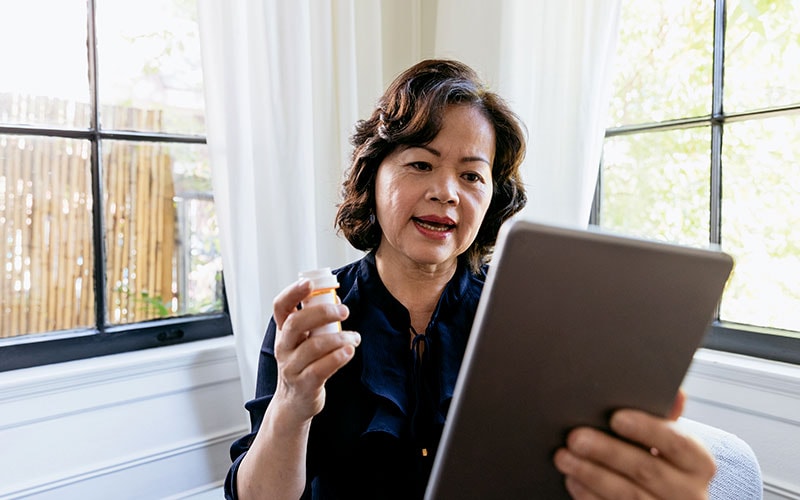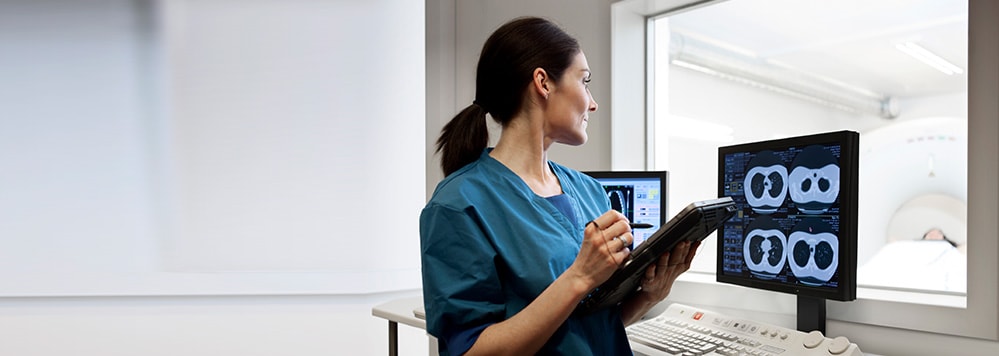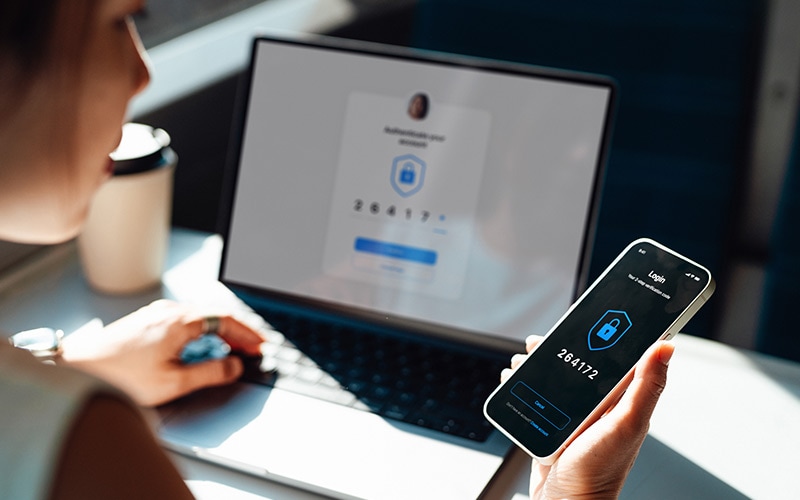The results of clinical drug trials can mean billions of dollars for pharmaceutical companies, and life or death for some patients. With such stakes, the process for drug approvals must have a highly structured foundation to protect the integrity of the data. However, that foundation was upended in 2020.
The COVID-19 pandemic has forced drug-makers to rethink how they manage trials, which typically rely on person-to-person contact. Increasingly, pharmaceutical companies are using electronic systems such as telephonic, web-based interviews and other technologies to shift trials from a clinical setting to the subjects’ homes. This was a necessity created by the current public health crisis, but it also offers new opportunities. Virtual clinical trials (VCT) or remote trials could broaden the pool of people available for clinical trials, more easily capture subjects’ data and ultimately speed up the development of new vaccines and other drugs.
Data collection in clinical trials
Researchers in drug trials typically collect observations directly from the subjects, while ensuring no bias is introduced. Data collection traditionally happens on-site at a clinic or sometimes in remote/VCT mode in a setting unsupervised by medical professionals such as at home or work. In case of physical visits to clinic, the logistics can be a burden for both sides. Trial participants and investigators need to coordinate schedules and travel to capture data. At certain stage, investigators have to update documents electronically. That can make the process prone to errors, time-consuming and expensive, even when there are relatively few subjects.
However, the unprecedented speed at which multiple coronavirus vaccines were developed this year show that drug research can be fast and effective with remote or hybrid clinical trials. Post COVID-19, these new clinical trial models are likely to become the norm rather than an emergency response to a once-in-a-century crisis.1
More inclusive clinical trials
Even before the pandemic, advances in technology had improved the gathering of patient-reported outcomes (PRO) and related data. Experience showed, unsurprisingly, that unsupervised paper-based self-reporting is less reliable than data collected electronically, according to research led by Stephen Joel Coons, professor emeritus at the University of Arizona’s College of Pharmacy. This led to the emergence of electronic PRO (ePro) technologies. The article further mentions “The movement from paper-based patient-reported outcomes to ePRO data capture has enhanced the integrity and accuracy of clinical trial data and is encouraged by regulators…. Handheld touchscreen-based devices have become the mainstay for remote (i.e. off-site, unsupervised) PRO data collection in clinical trials.” 2
An important feature of ePRO is the ability to automate interviews. That eliminates some of the human intervention and avoids potential biases. Further, timely reminders 3 improve compliance and keep the subjects engaged. That engagement also leads to improved subject retention, which has traditionally been another major problem with clinical trials. 4 Research from the U.S. National Academies of Sciences, Engineering and Medicine found that dropout rates from these trials were sometimes more than 30%. 5
ePRO helps reduce human dependency and avoid potential biases by automating interviews
Figure 1. The standard clinical trial process
Source: Infosys
Researchers currently use two automated interview ePRO technologies:
- Interactive voice response (IVR) — These telephone-based interviews deliver voice prompts and allow for phone keypad responses.
- Web-based touch screens — These web-based interviews deliver electronic written prompts and collect responses via mouse click or device touch screens.
However, both the ePRO methods exclude potential trial participants who may struggle with the system. Those include some elderly people, and patients with vision problems, neuropathic issues, or motor dysfunctions. 6 Automated voice response can ease or remove those limitations.
Voice enhancements
An automated “web-based voice” interview method developed at the Infosys Center for Emerging Technology Solutions (iCETS) is an enhancement to the screen-based system. The visual aspects remain intact, but the touchscreen or mouse actions are replaced by voice inputs and commands. This brings forth the best attributes of both IVR and the web-based touchscreen methods. This combination can be particularly effective. “Sharing visual content during conversations can boost comprehension and recall up to 600%,” according to developmental molecular biologist John Medina, author of the best-selling book Brain Rules. 7
This hybrid approach not only addresses the challenges faced by vulnerable populations but also provide greater convenience for everyone. This further reduces barriers for participants and potentially enhances retention.

Here are some benefits of the web-based voice approach over existing interview options:
IVR
- Voice interview over web creates a larger trial pool and increases the participation of more types of people who might otherwise have difficulty with other technology. 8
- Continuous voice authentication will ensure the authorized subject is the one answering the questions.
- Data can be stored locally and transmitted later when the network is available. This reduces risk of interruptions to the interview potentially leading to loss of data or repeat of the interview, due reasons ranging from poor network connectivity to power disruptions affecting the network.
- Users can start interviews at their convenience, within a scheduled time. 9
- Secure communication channels eliminate the possibility of unauthorized access during data exchanges. 10
- A menu-driven interface enables more accurate selections since both voice and visual mode are available. 11
Touchscreen
- Voice-based surveys can reach a broader range of test subjects, including elderly subjects or others not having access to smart devices. 12
- Patients are more engaged and less likely to forget to update a questionnaire. 13
- Voice recognition replaces passwords in web-based voice interviews. This reduces the chances that someone else could respond on behalf of the subject.
- The web-based voice data collection technology provides subjects with convenience, and enhanced user experience, better engagement and accuracy in recording their responses. This will also benefit the investigators, sponsors, and clinics by reducing the time, cost, and physical space needed to set up trials, fostering VCTs. Automated voice interviews can apply more broadly across clinical observation assessments.
- Here are the key features of an automated web-based voice interview system:
- A light application that can work with, or independent of, existing clinical trial products.
- Persona-based menus supporting specific activities for sponsors, investigators, and subjects. Administrative options to manage personas, protocols, and questionnaires.
- Standardized and customizable questionnaires to ensure ease of use by the subjects.
Figure 2. How web-based voice can work in remote clinical trials
Source: Infosys
- Voice over and visual display of instructions, questions and subsequently capture of subject responses. This enabled by accurate speech-to-text and text-to-speech conversion, and artificial intelligence and machine learning-based response validation (identifying closest matching option, non-valid response, confirmation of the response, repeating the questions and options), and finally recording for further processing by Electronic Data Capture (EDC) systems.
- Summarized response view to ensure subjects can correct answers, if needed.
- Gamification to encourage subjects to respond regularly.
- Launch of questionnaire based on predetermined schedule, with necessary reminders.
Web-based voice data collection boosts user experience and engagement while making the recording process more convenient and accurate
Conclusion
Even in a post-pandemic world, drug trials are unlikely to return to their previous status quo. The restrictions of 2020 have forced pharmaceutical companies and researchers to lean more heavily on technology and learn how to operate remotely. Increasingly, they have found that this new model is more efficient, provides a patient-centric experience and can increase data accuracy. Those benefits reach beyond the bottom line and into the lives of millions.
With inputs received from Vishal Goyal, AVP - Client Services Domain, Infosys and Suyash Nigam, Senior Consultant Domain, Infosys.
References
- Being Resilient: Change the Setting to Keep Drug Trials Running, Robert Liebman, Ravinder Singh, Sakshi Mangal, and Chad Watt, September 2020, Infosys Knowledge Institute.
- Capturing Patient-Reported Outcome (PRO) Data Electronically: The Past, Present, and Promise of ePRO Measurement in Clinical Trials, Stephen Joel Coons, Sonya Eremenco, J. Jason Lundy, Paul O’Donohoe, et al. October 2014, Springer Open Choice.
- Comparison of an interactive voice response system and smartphone application in the identification of gout flares, Nada Elmagboul, Brian W. Coburn, Jeffrey Foster, Amy Mudano, et al. June 2019, Arthritis Research & Therapy.
- Remote Clinical Trials in China During the COVID-19 Pandemic, Ying Liang, June 2020, globalforum.diaglobal.org.
- The Prevention and Treatment of Missing Data in Clinical Trials, 2010, National Academies of Sciences, Engineering, and Medicine
- BYOD 2.0: A More Inclusive Approach to eCOA in Clinical Trials, Chris Watson, November 2019, ERT.
- New Survey Finds Consumers Would Use Visual IVR for Customer Service Needs If Given the Option, Jenny Viscarolasag, Oct. 11, 2017, Hughes Communications.
- BYOD 2.0: A More Inclusive Approach to eCOA in Clinical Trials, Chris Watson, November 2019, ERT.
- New Survey Finds Consumers Would Use Visual IVR for Customer Service Needs If Given the Option, Jenny Viscarolasag, Oct. 11, 2017, Hughes Communications.
- New Survey Finds Consumers Would Use Visual IVR for Customer Service Needs If Given the Option, Jenny Viscarolasag, Oct. 11, 2017, Hughes Communications.
- New Survey Finds Consumers Would Use Visual IVR for Customer Service Needs If Given the Option, Jenny Viscarolasag, Oct. 11, 2017, Hughes Communications.
- BYOD 2.0: A More Inclusive Approach to eCOA in Clinical Trials, Chris Watson, November 2019, ERT.
- BYOD 2.0: A More Inclusive Approach to eCOA in Clinical Trials, Chris Watson, November 2019, ERT.







